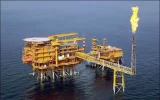Iran with 37 gas fields; still dreaming of getting rid of imbalance

According to Energy Press, Iran, as the second country with the world’s largest natural gas reserves, has been struggling with a complex equation for years; on the one hand, it has huge gas resources, and on the other, it is facing an energy imbalance crisis and shortage in gas supply. While gas has become one of the most important tools of power in international relations today, Iran’s geopolitical position is under threat due to domestic and foreign challenges.
Great wealth, small exploitation
With 37 recoverable gas fields, Iran has about 17 percent of the world’s gas reserves. The majority of these fields are located in the south of the country, the northeast, and the Caspian Sea, and in terms of capacity, they have the potential to transform Iran into one of the world’s great energy powers.
South Pars; the jewel of Iran’s reserves
The South Pars gas field, known as the world’s largest gas field, is jointly owned by Iran and Qatar. While Qatar is rapidly developing this field and exporting liquefied gas to all corners of the world, Iran continues to extract at a slower pace and is lagging behind this competition.
The Challenge of Shared Fields
Another challenge for Iran is the shared gas fields with neighboring countries. The Arash field in the northern Persian Gulf is shared with Kuwait and Saudi Arabia; a field that Iran has lagged behind in extraction for years, and regional competitors have taken a larger share of its reserves.
Onshore Sweet Gas; Domestic Support
In the onshore sector, large fields such as Tabnak, Aghar, Khanqiran, and Kangan are the main pillars of the country’s gas supply. These fields produce sweet gas that can be injected directly into the national grid and meet a significant portion of domestic demand.
Tags:gas
- Comments sent by you will be published after approval by site administrators.
- Comments that contain slander will not be published.
- Comments that are not in Persian or not related to the news will not be published.

Comments
Total comments : 0 Awaiting review : 0 Date: 0